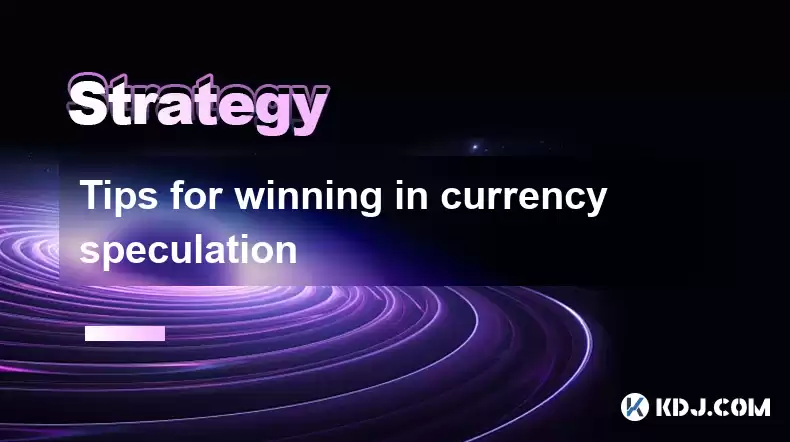-
 bitcoin
bitcoin $122659.385674 USD
0.52% -
 ethereum
ethereum $4484.113342 USD
-0.09% -
 bnb
bnb $1304.229256 USD
-0.85% -
 tether
tether $1.000204 USD
-0.03% -
 xrp
xrp $2.860636 USD
-0.51% -
 solana
solana $227.288799 USD
2.36% -
 usd-coin
usd-coin $0.999805 USD
0.01% -
 dogecoin
dogecoin $0.252837 USD
1.18% -
 tron
tron $0.341149 USD
1.12% -
 cardano
cardano $0.830507 USD
0.33% -
 hyperliquid
hyperliquid $45.792319 USD
0.04% -
 chainlink
chainlink $22.422164 USD
1.55% -
 ethena-usde
ethena-usde $1.000283 USD
0.01% -
 sui
sui $3.511389 USD
0.83% -
 stellar
stellar $0.385276 USD
-0.44%
Tips for winning in currency speculation
Currency speculation involves buying and selling currencies to profit from exchange rate fluctuations, requiring an understanding of fundamental concepts, thorough research, and effective risk management strategies to maximize profitability.
Jan 08, 2025 at 06:34 am

- Understanding the Basics of Currency Speculation
- Conducting Thorough Research and Analysis
- Implementing Effective Risk Management Strategies
- Mastering Technical Analysis Techniques
- Staying Informed about Market News and Events
- Utilizing Leverage and Margin Trading Safely
- Controlling Emotions and Making Rational Decisions
Understanding the Basics of Currency Speculation
Currency speculation, often referred to as forex trading, involves buying and selling currencies with the intention of profiting from changes in their exchange rates. Unlike stock investments, currency speculation markets are open 24 hours a day, five days a week, allowing for continuous trading opportunities.
Before embarking on any speculative activities, it is essential to grasp the fundamental concepts of currency pairs, exchange rates, and market spread. Gaining an in-depth understanding of these key elements will lay the foundation for informed trading decisions and successful outcomes.
Conducting Thorough Research and Analysis
Thorough research and analysis are crucial for identifying profitable trading opportunities in the currency speculation market. This process encompasses:
- Market Analysis: Assessing the overall health and direction of the economy, including factors such as GDP growth, inflation rates, and interest rates. Understanding these macroeconomic indicators provides valuable insights into potential market trends.
- Technical Analysis: Examining price charts to identify patterns, trends, and support and resistance levels. Technical analysis methodologies offer probabilistic trading signals that can improve the accuracy of speculative decisions.
- Fundamental Analysis: Studying economic and political events, news, and market sentiment. This analysis seeks to uncover potential catalysts that can influence currency exchange rates and market volatility.
- News Trading: Staying abreast of real-time events such as central bank announcements, political developments, and natural disasters. Immediate responses to news releases can capitalize on market reactions and increase profitability.
Implementing Effective Risk Management Strategies
Risk management plays a fundamental role in safeguarding capital and ensuring the long-term success of currency speculation. Effective strategies include:
- Proper Position Sizing: Determining an appropriate number of units to trade based on available capital and acceptable risk tolerance levels. This step ensures the potential losses do not exceed predetermined thresholds.
- Stop-Loss Orders: Setting automatic orders to exit a trade at a specific price, limiting potential losses in case of adverse price movements. This strategy helps protect capital and prevent significant drawdowns.
- Take-Profit Orders: Instructing the trading platform to automatically close a trade at a predetermined profit target. This proactive measure secures potential profits and prevents unnecessary risks.
- Hedging Strategies: Employing offsetting positions in multiple currencies to mitigate risk and volatility. Hedging offers an avenue to reduce exposure and preserve capital during periods of heightened market instability.
Mastering Technical Analysis Techniques
Technical analysis is a pervasive tool in currency speculation, offering traders a structured approach to identifying trading opportunities and predicting market trends. Some commonly used techniques include:
- Trend Analysis: Recognizing and following major market trends, such as uptrends, downtrends, or sideways movements. This analysis provides valuable insights into price direction and potential turning points.
- Support and Resistance Levels: Identifying price levels that serve as historical support (lower limit) or resistance (upper limit) points. These levels are often areas where market momentum may pause or reverse.
- Moving Averages: Smoothing out price data to identify overall trends and market direction. By calculating the average price over a specified period, moving averages provide a clearer perspective on market movements.
- Candlestick Patterns: Studying the visual representation of price action through candlestick patterns. These patterns offer insights into market sentiment, potential reversals, and continuation of trends.
Staying Informed about Market News and Events
Staying informed about market news and events is paramount in currency speculation. Economic data releases, geopolitical events, natural disasters, and central bank decisions can significantly impact exchange rates and market volatility.
Subscribing to news feeds, monitoring economic calendars, and utilizing trading platforms that provide real-time news alerts empower traders with the latest market information. Responding swiftly to breaking news and events can provide a competitive edge and lead to profitable trading outcomes.
Utilizing Leverage and Margin Trading Safely
Leverage and margin trading are techniques that allow traders to increase their potential profits by trading on borrowed capital. However, these strategies come with inherent risks and should be used cautiously.
- Understanding Leverage: Leverage refers to the ratio of borrowed funds to the trader's own capital. Higher leverage amplifies both potential profits and losses, and thus requires a robust risk management strategy.
- Margin Trading: Margin trading involves borrowing funds from a brokerage firm to increase trading capacity. Margin accounts are typically subject to margin calls, which occur when account equity falls below a certain level, requiring additional capital or position adjustments.
- Risk Management for Leveraged Trading: Implementing stop-loss orders, carefully managing position sizing, and maintaining a sufficient margin level are essential safeguards when utilizing leverage and margin trading.
Controlling Emotions and Making Rational Decisions
Currency speculation can evoke strong emotions, especially during periods of market volatility. Maintaining composure and making rational decisions is crucial for successful trading.
- Emotional Discipline: Recognizing and controlling emotional biases such as fear, greed, and revenge trading is paramount. Emotional decision-making often leads to impulsive trades and significant losses.
- Trading Plan: Developing and adhering to a pre-defined trading plan provides a structured approach to trading decisions. This plan should outline entry and exit strategies, risk management parameters, and trading hours.
- Trading Psychology: Training oneself in trading psychology can improve emotional resilience, increase discipline, and promote rational decision-making. Emotional control is a vital skill that separates successful traders from the majority.
Q: What are the most important factors to consider in currency speculation?A: Market analysis, technical analysis, risk management, understanding leverage and margin trading, controlling emotions, and staying informed about market news and events are all crucial factors in currency speculation.
Q: What is the best technical analysis technique for currency speculation?A: There is no universally superior technical analysis technique. Different techniques are suitable for different market conditions and trading styles.
Q: How much leverage should I use in currency speculation?A: The appropriate amount of leverage depends on risk tolerance, trading capital, and market conditions. However, excessive leverage is generally not advisable.
Q: How can I control emotions in currency speculation?A: Developing a trading plan, understanding trading psychology, and seeking professional guidance when necessary can help control emotions.
Q: What are the potential risks of currency speculation?A: Currency speculation carries the risk of capital loss due to adverse price movements, leveraged trading losses, and emotional decision-making.
Disclaimer:info@kdj.com
The information provided is not trading advice. kdj.com does not assume any responsibility for any investments made based on the information provided in this article. Cryptocurrencies are highly volatile and it is highly recommended that you invest with caution after thorough research!
If you believe that the content used on this website infringes your copyright, please contact us immediately (info@kdj.com) and we will delete it promptly.
- Trump Coin ETF, DTCC Listing, TRPC Ticker: A New Era for Political Meme Coins?
- 2025-10-09 11:40:03
- NYSE, Polymarket, and MAGACOIN: Wall Street Bets on Web3, Retail Traders Follow Suit
- 2025-10-09 11:40:03
- Crypto Clash: Unpacking the Mercury Funds Token Dispute
- 2025-10-09 11:40:03
- FLOKI, MoonBull, and the Meme Coin Mania: What's the Hype?
- 2025-10-09 11:40:14
- Nobel Peace Prize, 2025: Trump's Chances, Facts, and Circumstances
- 2025-10-09 11:40:14
- Stellar (XLM): Bull Target in Sight After Long-Term Breakout?
- 2025-10-09 11:45:13
Related knowledge

Practical parameter settings for a Bitcoin multi-timeframe moving average system
Sep 18,2025 at 10:54pm
Optimizing Timeframe Combinations for Bitcoin Trading1. Selecting appropriate timeframes is crucial when building a multi-timeframe moving average sys...

How can I filter out false breakouts in Dogecoin high-frequency trading?
Sep 22,2025 at 01:00am
Understanding False Breakouts in Dogecoin Trading1. A false breakout occurs when Dogecoin's price appears to move beyond a defined support or resistan...

Techniques for identifying tops and bottoms in the Bitcoin on-chain NVT model
Sep 20,2025 at 07:54pm
Understanding the NVT Model in Bitcoin Analysis1. The Network Value to Transactions (NVT) ratio is often described as the 'P/E ratio' of the cryptocur...

What does the surge in open interest in Bitcoincoin futures mean?
Sep 20,2025 at 11:18pm
Understanding the Surge in Dogecoin Futures Open Interest1. A surge in open interest within Dogecoin futures indicates a growing number of active cont...

How can I use the Ethereum USDT premium to gauge market sentiment?
Sep 18,2025 at 11:55pm
Understanding the Ethereum USDT Premium1. The Ethereum USDT premium refers to the price difference between USDT (Tether) traded on Ethereum-based plat...

What should I do if Ethereum staking yields decline?
Sep 20,2025 at 06:18am
Understanding the Causes Behind Declining Ethereum Staking Yields1. The Ethereum network transitioned to a proof-of-stake consensus mechanism with the...

Practical parameter settings for a Bitcoin multi-timeframe moving average system
Sep 18,2025 at 10:54pm
Optimizing Timeframe Combinations for Bitcoin Trading1. Selecting appropriate timeframes is crucial when building a multi-timeframe moving average sys...

How can I filter out false breakouts in Dogecoin high-frequency trading?
Sep 22,2025 at 01:00am
Understanding False Breakouts in Dogecoin Trading1. A false breakout occurs when Dogecoin's price appears to move beyond a defined support or resistan...

Techniques for identifying tops and bottoms in the Bitcoin on-chain NVT model
Sep 20,2025 at 07:54pm
Understanding the NVT Model in Bitcoin Analysis1. The Network Value to Transactions (NVT) ratio is often described as the 'P/E ratio' of the cryptocur...

What does the surge in open interest in Bitcoincoin futures mean?
Sep 20,2025 at 11:18pm
Understanding the Surge in Dogecoin Futures Open Interest1. A surge in open interest within Dogecoin futures indicates a growing number of active cont...

How can I use the Ethereum USDT premium to gauge market sentiment?
Sep 18,2025 at 11:55pm
Understanding the Ethereum USDT Premium1. The Ethereum USDT premium refers to the price difference between USDT (Tether) traded on Ethereum-based plat...

What should I do if Ethereum staking yields decline?
Sep 20,2025 at 06:18am
Understanding the Causes Behind Declining Ethereum Staking Yields1. The Ethereum network transitioned to a proof-of-stake consensus mechanism with the...
See all articles










































































